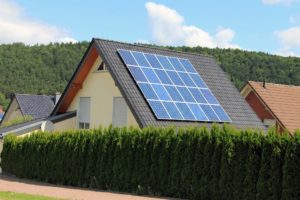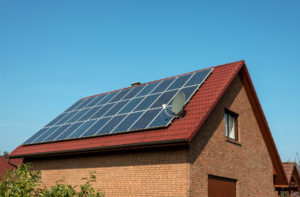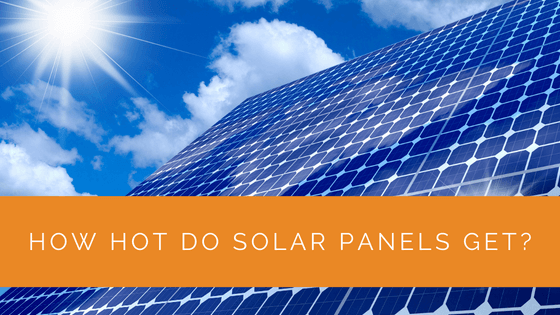Solar panels are designed to operate in high heat. Thus, it is quite unlikely that they would ever become so hot that they’d be rendered useless.
The temperature coefficient of a solar PV panel may be used to calculate the degree to which heat affects the panel’s ability to produce electricity. This article will explore the impact of temperature on solar panels’ performance and power output.
Contents
- 1 Key Takeaways
- 2 Understanding Solar Panels Work Efficiently
- 3 What Is an Optimal Temperature for Solar Panel Efficiency?
- 4 What is a Temperature Coefficient?
- 5 Ways to Keep Your Solar Panel Cool
- 6 Case Study: Enhancing Solar Panel Efficiency in Hot Climates
- 7 Expert Insights From Our Solar Panel Installers About How Hot Do Solar Panels Get
- 8 Experience Solar Excellence with Us!
- 9 Wrapping Up
Key Takeaways
- Solar panels are designed to withstand high temperatures and remain operational. They are most efficient at around 77 degrees Fahrenheit.
- The temperature coefficient of solar panels determines how much their energy output decreases as the temperature rises. A low coefficient is preferable.
- To keep solar panels cool and maintain efficiency, options include using thermally conductive substrates, raising panels above the roof, installing air circulation systems, using light-colored materials, and relocating heat-producing equipment. High-quality panels are also recommended for better performance and durability.
Understanding Solar Panels Work Efficiently
Photovoltaic or solar cells transform the sun’s rays into electricity and are used in solar power systems. The proportion of light that contacts the surface of a solar cell and is turned into solar electricity is referred to as solar panel efficiency.
Rooftop monocrystalline and polycrystalline solar panels can comprise approximately 60-72 solar cells. Most renowned solar brands have an efficiency of 15% to 20%, which means roughly 15% to 22% of the sunlight that reaches the panel is transformed into useful power.

What Is an Optimal Temperature for Solar Panel Efficiency?
Like all electrical equipment, solar panels operate most efficiently when kept as cold as possible. The rated maximum output of solar panel installation is measured at 77 degrees Fahrenheit (25 degrees Celsius) with a thousand watts of light every square meter shining on them.
While these Standardized Testing Conditions (STC) are unrealistic, they aim to ensure that your solar panel systems can generate power under perfect conditions. For instance, most solar power panels are 250-350 watt solar energy panels. Thus, they must be capable of 250-350 watts of energy production under the abovementioned testing.
Most solar power systems have a reported maximum temperature of 185 degrees Fahrenheit, which is quite high. Solar panels are hotter than the air temperature because they absorb the sun’s heat. Due to their high durability, high temperatures would not damage them.

What is a Temperature Coefficient?
A solar panel manufacturer’s data sheet is the best approach to discovering your solar power systems’ heat tolerance. There’s a phrase there called temperature coefficient. It indicates how much energy will be lost if the air temperature increases by one °C over 25°C.
A low-temperature coefficient is preferable. The loss in output is modest, barely about .5%; therefore, you should not notice any difference in the performance of your solar panels.
Assume you have a solar system for brand Z, and the solar cell temp is 45 degrees Celsius. That is 20 degrees Celsius above STC. To calculate how much the output power will drop, multiply the 20° C differential by a -0.29% temperature coefficient. This results in a 5.8% decrease in the component’s power output.
That implies that when the panels reach 45 degrees Celsius, the module’s maximum power production drops to 329.7 watts rather than 350. This means your panels continue to generate sufficient energy to run your home.

Ways to Keep Your Solar Panel Cool
Following the selection of a solar installer, there are numerous options for minimizing the harmful impacts of high temperatures:
Quality Is Important
Before we get into the tactics for keeping solar panels cool, it’s important to note that quality significantly influences the longevity and performance of solar panels. Even though the cost to install higher-quality solar panels may seem a lot, they will last longer and are much less likely to be harmed by overheating or UV deterioration.
Utilize a Substrate
A thermally conductive substrate is one way to keep your solar panels cool. The heat will be evacuated and deflected away from the panes of glass of the solar power panels, which are sensitive to getting overheated. The substrate places a layer beneath them that can transfer heat.
A basic cement or back sheet layer beneath the panel greatly reduces the danger of overheating it. Most heat is transferred via the substrate surface rather than the solar panel system.
Raise the Solar Panels
Layers are crucial in this case. In addition to conducting heat, the underlying layers will lift the solar panel off the rooftop and allow for enhanced ventilation.
You may maintain the panels a few inches above the roof using thin metal layers. This keeps the heat from the roofing apart from the photovoltaic panels and gives a good flow of fresh air to help keep the panels cool.
Alternatively, you might position the panels a couple of inches above the roof during installation. This way, the panels can be cooled by the passage of convective air.

Install a Method of Air Circulation
Setting up fans, valves, or a ventilation system are all viable alternatives to maintain a pleasant airflow and keep the solar panels at a comfortable temperature. However, setting up a ventilation system is slightly more complicated.
Install a Thermometer
Please put in a thermometer to check the temperature of your solar panels so you’ll know when they must be cooled down. In such cases, the panels could require a substrate to disperse the heat or additional elevations from the rooftop to enable a higher airflow through the system.
Use Light Color Materials
Make sure that the panels are built using materials that have a light hue. This will limit the amount of heat absorbed but not entirely, thus not rendering your purchase useless.
Moving Heat Producing Equipment
Combiners, solar inverters, and other components should be moved into the shaded region behind the arrangement. The heat generated from these can result in a rise in temperature in your panels.
Case Study: Enhancing Solar Panel Efficiency in Hot Climates
Background
Solar Panels Network USA collaborated with a residential community in Arizona, known for its extreme summer temperatures, to optimize their solar panel installations. The goal was to enhance the efficiency and longevity of the solar panels by addressing the challenges posed by high temperatures.
Project Overview
The community experienced significant drops in solar panel efficiency during the hottest months. This case study aimed to identify effective strategies to mitigate the impact of high temperatures on solar panel performance, ensuring consistent energy production throughout the year.
Implementation
Assessing the Existing Setup
Our team began by conducting a thorough assessment of the existing solar panel installations. We measured the temperature of the panels during peak sunlight hours and analyzed the temperature coefficient of the installed solar panels. This initial assessment provided insights into the extent of efficiency loss due to heat.
Introducing Thermally Conductive Substrates
One of the key strategies implemented was the use of thermally conductive substrates. We placed a layer of thermally conductive material beneath the solar panels to dissipate heat away from the panels. This substrate effectively reduced the operating temperature of the panels, enhancing their efficiency.
Raising the Panels for Improved Ventilation
To further mitigate the impact of heat, we raised the solar panels a few inches above the roof using metal brackets. This elevation allowed for better air circulation underneath the panels, facilitating natural cooling through convective air flow. This method significantly reduced the panel temperatures during peak heat.
Installing a Ventilation System
In addition to raising the panels, we installed a passive ventilation system. This system included strategically placed vents and fans to maintain a continuous airflow around the solar panels. The ventilation system ensured that the heat generated by the panels and the surrounding roof was efficiently dissipated.
Using Light-Colored Materials
We recommended and implemented the use of light-colored materials for the panel frames and surrounding structures. These materials reflected more sunlight, reducing the overall heat absorption by the solar panel system. This simple yet effective strategy contributed to maintaining lower operating temperatures.
Results
The combination of these strategies resulted in a noticeable improvement in solar panel performance. The operating temperatures of the panels were significantly reduced, leading to enhanced efficiency and consistent energy production. The community reported a decrease in efficiency drops during the hottest months, ensuring a reliable energy supply throughout the year.
Summary
This case study demonstrates the effectiveness of strategic interventions to mitigate the impact of high temperatures on solar panel efficiency. By incorporating thermally conductive substrates, raising the panels for better ventilation, installing passive ventilation systems, and using light-colored materials, Solar Panels Network USA successfully enhanced the performance of solar panels in a hot climate. These strategies not only improved energy production but also extended the lifespan of the solar panels, providing long-term benefits to the community.
Through continuous innovation and expertise, we remain committed to delivering sustainable and efficient solar energy solutions tailored to diverse environmental challenges.
Expert Insights From Our Solar Panel Installers About How Hot Do Solar Panels Get
Understanding the temperature coefficient of your solar panels is crucial. A low coefficient ensures minimal power loss as temperatures rise, which is essential for maintaining efficiency in hotter climates.
Senior Solar Installer
Proper installation techniques, like raising the panels above the roof, can significantly reduce the impact of heat on solar panels. This method enhances ventilation, keeping the panels cooler and maintaining their efficiency.
Lead Solar Technician
Using high-quality materials and components is paramount. High-quality solar panels are better equipped to withstand high temperatures and UV radiation, ensuring long-term performance and durability.
Solar Installation Expert
Experience Solar Excellence with Us!
Trust in Solar Panels Network USA, where our seasoned experts deliver top-quality solar solutions for homes and businesses nationwide. With a legacy of countless successful installations and a commitment to sustainable energy, we’re your reliable partner in the solar journey. Ready for a brighter, eco-friendly future? Call us now at (855) 427-0058 and harness the sun’s power!
Wrapping Up
Take care to keep your solar systems cool and operational. Investing in a well-known solar panel brand is your safest bet for quality and durability.
The components of solar panels are designed to operate in extreme heat and direct sunlight. Selecting a high-quality panel eliminates concerns about heat affecting solar energy production.
Yet, by collaborating with a skilled solar installer, you may reap the long-term benefits of your solar panels.
About the Author
Solar Panels Network USA stands at the forefront of solar energy solutions, driven by a team of seasoned solar engineers and energy consultants. With over decades of experience in delivering high-quality solar installations and maintenance, we are committed to promoting sustainable energy through customer-centric, tailored solutions. Our articles reflect this commitment, crafted collaboratively by experts to provide accurate, up-to-date insights into solar technology, ensuring our readers are well-informed and empowered in their solar energy decisions.

